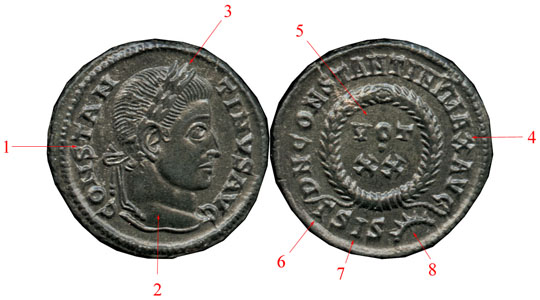
To identify and describe a Roman coin, one must specify its denomination, obverse type, obverse legend, reverse type, reverse inscription, and any other relevant marks, especially ones in its exergue.

Obverse legend
Indicated by [1], this coin reads CONSTANTINVSAVG. Text on Roman coins is generally in Latin, and often
abbreviated. Although English shares the same alphabet, making the text easy to read, the characters of the
time were slightly simplified -
in particular, J, U and W did not yet exist. I substitutes for both I and J, and V for U and V.
With this in mind, the legend
properly reads CONSTANTINUS AUG. CONSTANTINUS is a name - Constantine the Great who ruled from 307 to 337 AD.
Roman coins frequently include the name of the emperor that they were issued by and this is no exception.
Roman rulers held the title of Augustus, a title created by Octavian, the adopted son of Julius Caesar.
Augustus is abbreviated AUG. The legend thus reads "Constantine, Augustus".
Obverse type
Roman coins frequently have portraits of the emperor or empress that issued them. Constantine is shown
here facing "right". The portrait [2] is only from the neck up, so its described as a "head" rather than
a full bust. Constantine is wearing a laurel wreath [3], so this portrait is "laureate". The obverse
type can then be abbrevated "laureate head right", a.k.a. "Laur. hd. r." in the literature.
Reverse inscription
The reverse inscription [4] reads DNCONSTANTINVSMAXAVG. DN is the abbreviation for Dominus Noster, "Our
Lord". CONSTANTINVS is again his name, followed by MAX, the abbreviation of Maximus, and again AVG for
Augustus. The legend could then translate as "Our Lord, Constantine the Great, Augustus".
Reverse type
This coin is a votive issue - VOT XX in a wreath [5]. VOT is short for VOTA, VOTIS or VOTUM, indicating vows
to the gods. Vows are offered here for a twenty (XX - yes, Roman coins do have Roman numerals on them
at times) year reign.
Exergue
Not all coins have text or symbols in their exergues, but this one does. The exergue is the space below
the reverse design. The exergue of this coin contains [6] a Γ (a Greek gamma), [7] the letters SIS,
and [8] a sunburst. The Γ indicates which officina (workshop) at the mint produced this coin. Western
mints used Latin to number the officinae - P (prima, 1st officina), S (secunda, 2nd officina), T (tertia,
3rd officina), Q (quarta, 4th officina) and such. Eastern mints often used Greek letters, Α (alpha,
1st officina), Β (beta, 2nd officina), Γ (gamma, 3rd offina) and so on. The Γ of this coin
indicates it was minted at the third officina. The letters SIS indicate the mint - SIS is the abbreviation
for Siscia, now Sisak, Yugoslavia. Certain coins also have additional marks known as "series marks" which
were possibly used to indicate production runs. This coin has a sunburst series mark.
Denomination
The size, weight, composition and time period that a coin was issued indicate its denomination. From the
above, one knows this is a coin of Constantine, and from physical measurements its a copper coin about the
size of a United States cent. At this period in time, smaller denominations are only referred to now by
category - this size corresponds to category 3, and as its copper (abbreviated Æ), its "denomination" is an Æ3.
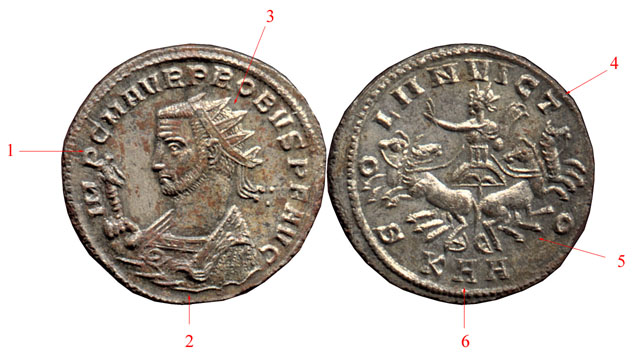
Obverse legend
Shown by [1], the legend reads IMP C M AVR PROBVS P F AVG. IMP, short for Imperator, was an honorary title
bestowed upon a general by his troops after a battle in which they were victorious, though later only the
emperor could be given this title. The word "emperor" comes from "imperator". C abbreviates Caesar,
originally indicating a family relationship with the family of Julius Caesar, it later became a title of the
emperor. M AVR PROBVS indicates the emperor himself, Marcus Aurelius Probus, who ruled from 276 to
282 AD. P F is Pius Felix, "dutiful
and wise", and AVG is once again Augustus. The legend is then "Imperator Caesar Marcus Aurelius Probus,
dutiful and wise, Augustus".
Obverse type
This portrait of Probus [2] is down below the shoulder, so it is a "bust" rather than just a head. He is
facing left, and is wearing the Imperial mantle and holding an eagle-tipped scepter. The headdress [3]
also identifies this portrait as the "radiate" style.
Reverse inscription
The inscription SOLI INVICTO [3] refers to Sol, the sun god. It is often seen as SOLI INVICTO COMITI,
"(to) the unconquerable sun god".
Reverse type
The inscription gives a hint to the reverse type - this is Sol, in a quadriga. Chariots with two horses
are biga, three are triga, and four are quadriga. The design looks a little odd as the technique of
perspective had not yet been developed.
Exergue
The letters KHA are in the exergue [6], possibly indicating the mint at Cyzicus, Turkey.
Denomination
This coin is about the size of a United States quarter, and based on its size, weight and legend its an
"antoninianus".
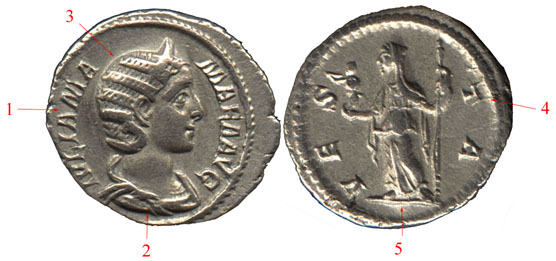
Obverse legend
[1] shows IVLIA MAMAEA AVG, and with the letter substitution it becomes "Julia Mamaea, Augusta" (Augusta is
the female version of Augustus). Although not as often as men on coinage, women, typically wives
or mothers of emperors, would have their own coin issues.
Obverse type
The portrait [2] is down to the shoulder, so it is a "bust", and the folds of cloth identify this bust
as "draped". The headdress [3] is the "diademed" style, so this is referred to as "diademed and draped
bust right", abbreviated "diad. and dr. bust r." in the literature.
Reverse inscription
VESTA [4]. As with the Probus antoninianus, Roman coin reverses often showed gods and goddesses. This
reverse shows Vesta, as in "Vestal virgin".
Reverse type
Once again, the inscription aids in identifying the reverse - Vesta standing left [5], holding a palladium (the
image of Minerva [Athena]) and a sceptre.
Exergue
This coin does not have anything in its exergue.
Denomination
As this is a silver coin, approximately the size of a United States nickel, it is a "denarius".
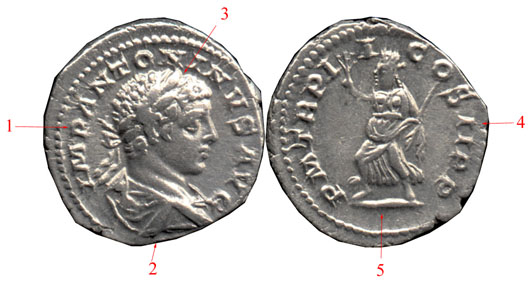
Obverse legend
[1] gives IMP ANTONINVS AVG. IMP is again Imperator. ANTONINUS, unlike the other legends, isn't immediately
clear. It is the ruler's name - Marcus Aurelius Antoninus - though he is commonly known as Elagabalus
because of the Syrian sun god that he worshipped.
Obverse type
As with the coin of Julia Mamaea, this bust [2] is also draped, and it is of the laureate style because
of the laurel wreath [3].
Reverse inscription
Unlike the other coins, this one has a list of titles that Elagabalus has assumed [4], reading
P M TR P II COS II P P. P M abbreviates Pontifex Maximus, the head priest of the Roman religion.
TR P is short for Tribunicia Potestas, the civil power and the emperor as the civil head of the Roman
state. This power was issued periodically - TR P II, the second issuance, occurred in 219 AD for
Elagabalus. COS indicates the Consul, a chief magistrate of the Roman state. COS II was obtained by
Elagabalus also in 219 AD. P P is Pater Patriae, the Father of the Country.
Reverse type
Also unlike the other coins the inscription does not aid in the identification of the reverse type. This
type is Pax running left, holding an olive branch and a scepter. In addition to gods and goddesses, Roman
coins often showed personifications of ideas - Pax is Peace, possibly indicating a peaceful time in the Empire,
or the recent end of a conflict.
Denomination
This coin is a denarius.
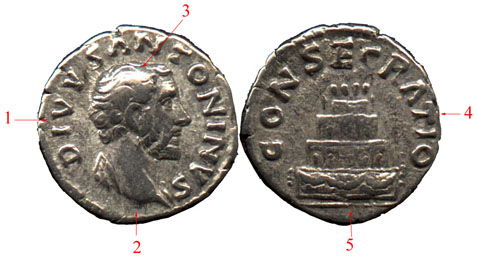
Obverse legend
Speaking of not obviously clear, although identification is usually straightforward,
this coin shows another reason why it is good to be careful when
identifying coins. The legend is DIVVS ANTONINVS [1], which at first glance would appear to be the
same ANTONINVS as the previous coin. The portrait, however, is different, and consultation with
Roman coin references shows that this coin is struck by Titus Aelius Caesar Antoninus, a.k.a Antoninus
Pius, and not Elagabalus. DIVUS means "god" and refers to a deified ruler after his death. In other words, this coin was
produced as a commemorative issue after the death of Antoninus Pius in 161 AD (known as a "posthumous
type") - it was struck by Marcus Aurelius
and Lucius Verus.
Obverse type
As the head [2] does not have any ornamentation [3], it is "bare", so this is "bare head right".
Reverse inscription
CONSECRATIO [4], the elevation to divine rank. At that time in the Empire, a popular emperor was
consecrated as a god upon his death and then worshipped by his successors.
Reverse type
In keeping with the theme of the coin the reverse shows a funeral pyre [5].
Denomination
This coin is a denarius.
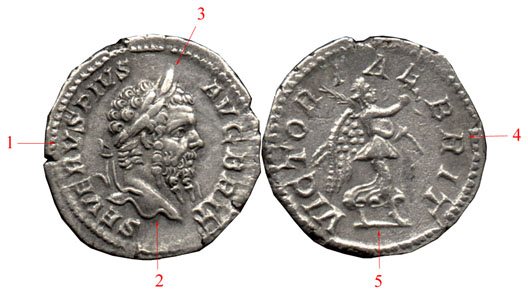
Obverse legend
SEVERVS PIVS AVG BRIT as shown by [1]. SEVERUS is Septimus Severus, PIUS is dutiful, and AUG is Augustus.
After certain events, emperors may take additional titles commemorating the event. As Severus won victories
in Britannia (modern Britain), his title was Britannicus, abbreviated BRIT.
Obverse type
Laureate [3] head [2] of Septimus Severus, facing right.
Reverse inscription
VICTORIAE BRIT [4]. Coins were often issued to commemorate particular events. This coin refers to the
battles won by Severus and his sons in 209 AD in what is now Scotland, i.e. "Victory in Britannia".
Reverse type
Victory (also a personification commemorating the result of the battles) advancing right [5], holding a palm
and a wreath.
Denomination
This coin is a denarius.
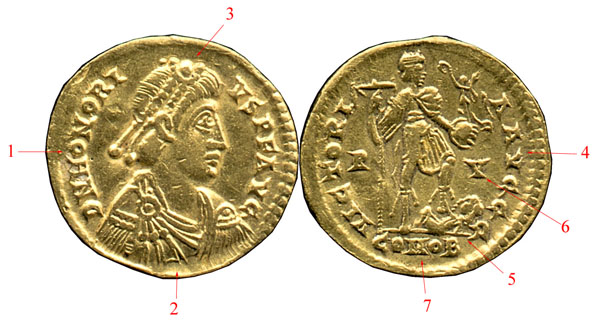
Obverse legend
DN HONORIVS PF AVG, as seen by [1]. As before, DN is Dominus Noster, "Our Lord", P F is Pius Felix, "dutiful
and wise", and AVG is "Augustus". HONORIVS identifies this coin as issued by Flavius Honorius.
Obverse type
Diademed [3], draped and curiassed (wearing armor) bust [2] of Honorius, facing right.
Reverse inscription
VICTORIA AVGGG, by [4]. Each G indicates a concurrently ruling Augustus - Honorius was one of three who
each ruled sections of the empire, though he presided over the Western empire and Rome.
Reverse type
Coins like this one were issued for their propaganda value rather than to commemorate an event or to honor
a god. Honorius is standing right [5], is resting his foot on a captive, and is holding a military standard
in his right hand and (the personification of) Victory in his left. It is ironic as it was Honorius who
presided over Rome when it was sacked in 410 AD - he neither subdued captives by hand nor was victorius
against the invaders.
By that time he had even fled Rome and moved his court north to Ravenna, as indicated by the R V [6]
in the field.
Exergue
COMOB [7]. COM indicates the Comitatus mint, the mint at the Emperor's court. As the court was in
Ravenna (by the R V) at the time, so was the mint. OB is "obryziacum aurum", or "fine gold".
Denomination
A United States nickel-sized gold coin of this period is a "solidus".